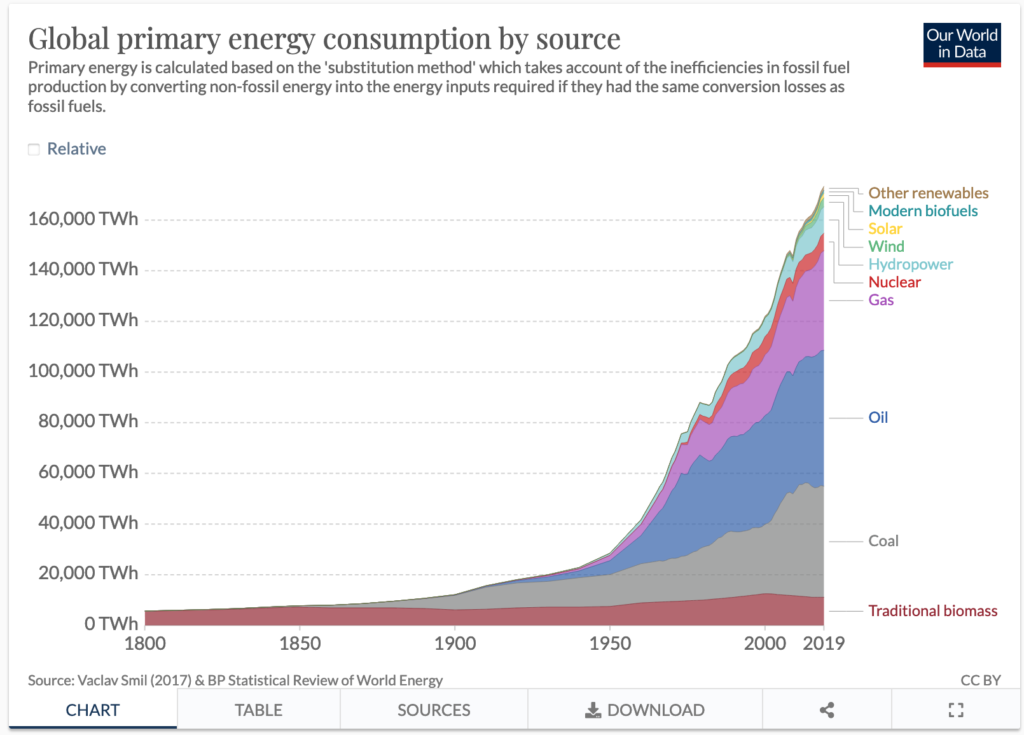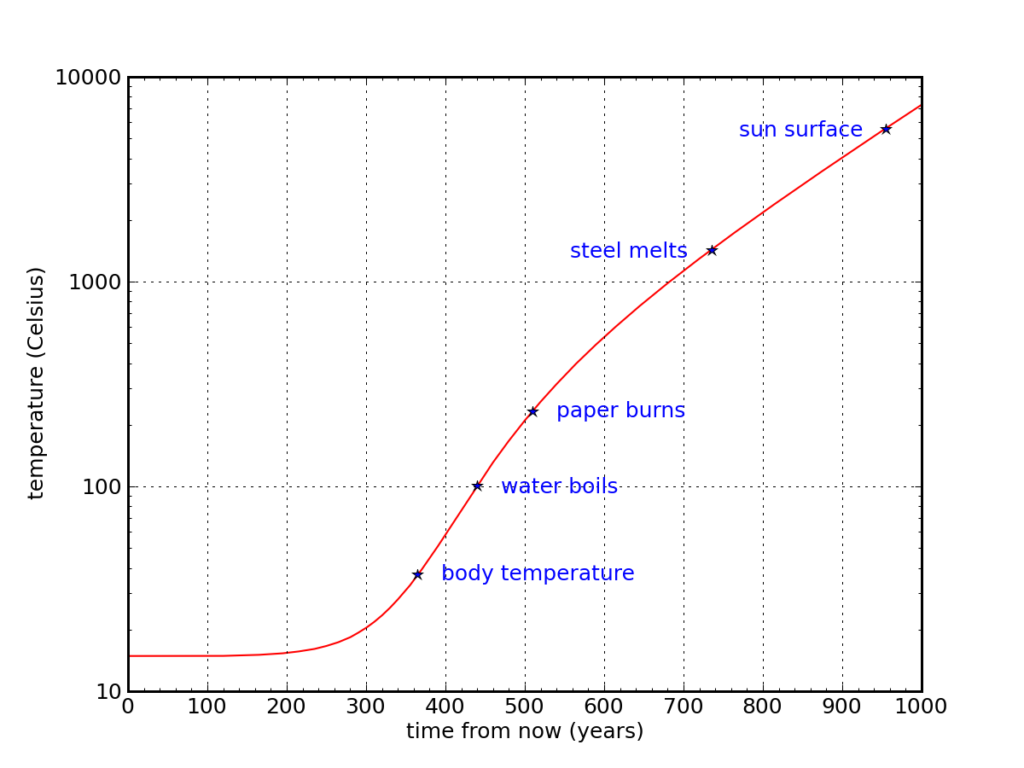1/ Imagine an economy that keeps on growing indefinitely. It’s essentially a non-zero-sum economy – as the pie becomes bigger, everyone becomes better as even a small percentage of a really large number is substantial.

2/ A capitalistic economy is a fantastic invention – entrepreneurs compete to give consumers more value cheaply. Markets create incentives for innovation, and innovation helps the world become richer as over time more and more human desires are satisfied.
3/ Economic wealth as measured by GDP is nothing but products and services available for purchase. Capitalism suggests these things will be up for purchase because people want them and we can make it. Hence, GDP approximates the total useful stuff available for humans.
4/ An important question to ask is if this process of innovation-led GDP growth can keep going for a long time.
And if it will ultimately come to a halt, how long can it go on?
5/ The answer to this question informs our moral choices and policies because if the economic growth engine stops and we have a fixed pie of useful stuff (i.e. GDP) to go around, the relatively less wealthy will not have any shot at becoming richer.
Under this zero-sum economy scenario, perhaps we should put an upper limit on how much wealth can any single individual claim ownership of.
5/ However, if indefinite economic growth is possible, we will have an ever-expanding pie for everyone.
Under the non-zero sum economy scenario, we should accelerate innovation because a strong case can be made towards the moral obligation for growing an economy because that’s the only way nations escape poverty.
5/ The world economy has grown at ~7.5% per year in the last six decades. This is an exponential growth rate and the math suggests that since 1960 (which incidentally isn’t very long ago – we had landed on the moon by then), our economy has grown 80 times.
6/ In fact, the data shows exactly this. In 1960, the world economy was $1.369 trillion (inflation-adjusted) and today it is $80 trillion.
Today we have 80 times more useful stuff than we had merely six decades ago.

7/ The math of exponential growth is dizzying. At the same growth rate, this means in the next 10 years we will add more (i.e. another $80 trillion) to our economy than the total we have right now (i.e. today’s $80 trillion worth of stuff).
8/ To reiterate the main question: where will this new stuff in the economy come from? How long can we keep up with the exponential growth?
9/ There are signs of economic growth slowing down. In fact, the average for the last 10 years has been in the 3% range (and not 7%).
However, with exponentials, the question usually is not of exact growth rate. As the famous wheat and chessboard story demonstrates, at any growth rate, an entity growing at an exponential rate quickly becomes insanely big.
10/ Even at a 3% growth rate, the economy would double every 23 years. This means within the next 100 years, our economy will have 16 more times stuff than today. Imagine everyone in the world being 16 times richer in the next 100 years, and being 250 times richer just in 200 years.
11/ And when I say richer, I mean in an inflation-adjusted sense. Future generations will have 250 times more things to buy and consume for the same amount of income.
Surely, this sounds good. Who doesn’t want more stuff?
12/ Given all the riches up for grabs due to exponential economic growth, we should ask ourselves:
- are there any limits to this growth?
- if there are limits to this growth, how should we act today?
- what are the costs of this growth?
13/ The question about limits to this growth has a simple but lazy answer. Eventually, the heat death of the universe puts a hard limit on how large our economy can be.
But let’s not worry about the heat death. Let’s limit ourselves only to the near-term future.
14/ A clue to the near-term limits of economic growth comes from the fact that humans are ultimately physical creatures and whatever we buy and consume requires energy.
Capitalism is a process of converting energy into work, producing entropy as a by-product.
15/ Our economies have grown in tandem with energy consumption.
Quite literally, to grow the GDP, you require energy and many economists suggest that the rapid economic growth we have seen in the last 100 years wouldn’t have been possible without the lucky discovery of fossil fuels.
Our exponential growth in the economy has required exponential growth in energy consumption.

16/ Fossil fuels will not last forever but we can have nuclear, renewables or other sources of energy.
So at least from the energetic point of view, there seem to be no limits on the size of the economy. Right?
17/ Not really. As this excellent analysis suggests, most of the energy we consume in our economy ultimately ends up as heat. Consider the car moving and vibrating air molecules, or you opening Gmail and Google’s servers heating up a bit more.
18/ In thermodynamics, there’s a simple equation that relates the amount of heat radiating to the temperature of the body radiating such heat.
Even without accounting for externalities like greenhouse gases or nuclear waste, you’ll discover that an exponential increase in energy consumption will quickly toast the earth.
19/ At a 2.3% growth rate in energy, within 1000 years, assuming all energy is consumed on Earth, the temperature of Earth’s surface will have to become equal to Sun’s surface temperature.
Clearly not a pleasant right.

20/ There are two potential counter-arguments to this line of reasoning:
a) economy’s growth gets delinked with energy growth due to increasing demand for digital goods/services (more than physical ones)?
b) what if we leave Earth and colonize space where there’s a lot more energy to go around?
21/ It’s possible that the economy has both physical and digital goods to go around, and in the future economic growth can come from digital goods.
After all, at $60k, a bitcoin (as of the time of writing this) is worth more than the price of most cars.
22/ However, it is not possible that economic growth gets completely delinked from energy growth.
All digital services require work to happen in the physical world and as long as such a digital-driven economy is growing exponentially, the energy requirement in the physical world will also grow at an exponential rate.
23/ It’s fiction that we can grow the digital economy without corresponding energy growth. Internet requires energy. Bitcoin requires a significant amount of energy. Even Minecraft requires energy.
24/ Even if the digital part of the economy grows exponentially and the physical part of the economy comes to a halt because of limited energy supply, ultimately this would mean the physical goods become infinitely cheap.
25/ But since physical goods (like microchips, fibers, etc.) are what runs the digital economy, there has to be a floor price for these (otherwise competition can destroy a company by buying up all supply of physical goods).
Clearly, the energy-driven limit on the physical production of goods limits the digital economy as well.
26/ Okay, so what if we simply expand in space and become a Kardashev level 2 civilization (using the energy of the entire solar system, including the Sun)?
Space exploration is sexy but we have to realize we have no evidence of the feasibility of anything like that. Space is demonstrably hostile to humans and distances between planets and stars are mind-bogglingly huge.
27/ Since the 1980s, the farthest humans have been to is the point (a) in the image below. Moon is the point (d) and Mars is 100 times further. “A three-day lunar journey becomes 260 days to Mars”.
See this post for more reasons why space is an infeasible option.

28/ We have never attempted anything like what’s required to utilize space for making more stuff for human consumption (which is what’s required to keep growing our economy without toasting Earth).
29/ That obviously doesn’t mean exploring space is a waste. Space exploration is great for advancing scientific knowledge.
But, because it’s so hostile and intractable, we cannot rely on it to power our economy anytime soon.
30/ Perhaps the reason we don’t see space-faring, advanced civilizations in space is because doing that at scale might be a million or billion times harder than what humans have achieved so far.
31/ Of course, some people will argue that physics allows it so we should be optimistic.
But I argue for realism – in absence of any evidence of utilizing space for economic growth and given how barren and unforgiving space is, we should hold our enthusiasm in check.
32/ Short aside: even if we utilize our entire solar system for powering the economy, the exponential growth will rear its ugly head again. Can we expand beyond the solar system?
The nearest star from Sun is 300,000 times farther than how far the Earth is from Sun. The Voyager probes that have reached beyond our solar system will take tens of thousands of years to reach the nearest star.
33/ To summarize, for growing our economy exponentially in the next few hundred years,
- either we toast the Earth by consuming more and more energy over time
- OR we rely on voodoo technology that doesn’t exist today.
34/ None of the two options seem realistic and hence my conclusion is that our economy’s growth will have to decelerate and finally halt within the next thousand years or so.
Much before the heat death of the universe, we will face the prospect of hitting the upper limits on human standards of living.
35/ In fact, we may not have to wait even a thousand years for our standard of life to drop.
The negative externalities of stuff we produce (such as greenhouse gases, pollution, garbage, biodiversity loss, attention loss, and so on) could pose a much bigger cost to humans than the benefit they get from producing and consuming more stuff.
36/ What does the finally stagnant economy imply morally is a difficult discussion.
But it’s definitely immoral to expect the poor nations to not grow their economies, and for poor people to not aspire for a lifestyle that rich enjoy.
37/ Perhaps the onus of making moral choices for future generations falls on the rich.
Either they can keep pushing the economy to its natural upper limit and leave consequences of that to be dealt with by future generations, or they can start making more informed choices today about what they consume, how they invest, and how much they donate.
Join 200k followers
Follow @paraschopra